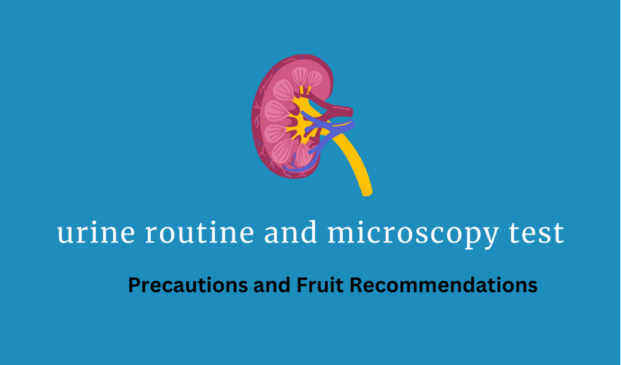Urine Routine and Microscopy is a common diagnostic test that provides essential information about a person’s kidney and urinary system health. It involves examining a urine sample to detect abnormalities and potential signs of various diseases. In this blog post, we’ll address frequently asked questions about the Urine Routine and Microscopy test, its significance, and how it benefits to you.
Frequently Asked Questions about Urine Routine and Microscopy, its precautions and fruit recommendations
Urine Routine and Microscopy, also known as Urinalysis, is a medical test that analyzes a urine sample to evaluate the physical, chemical, and microscopic properties of the urine. It helps in assessing the overall health of the urinary system, as well as detecting potential signs of certain medical conditions.
The test is essential for several reasons:
Detecting Kidney Disorders: It helps identify kidney diseases such as kidney stones, urinary tract infections (UTIs), and chronic kidney disease.
Monitoring Chronic Conditions: For individuals with pre-existing medical conditions like diabetes or hypertension, regular urine tests can help monitor the progression of the disease and its impact on the kidneys.
Identifying UTIs: Urinalysis can detect the presence of bacteria, white blood cells, and nitrites, which are indicative of a urinary tract infection.
Screening for Metabolic Issues: The test can indicate metabolic disorders like diabetes and liver problems.
Early Disease Detection: The test can detect early signs of various diseases, allowing for timely intervention and treatment.
Preventive Health Check: Regular urine tests can serve as a preventive health measure, helping individuals maintain good kidney health and overall well-being.
Treatment Monitoring: For patients undergoing treatment for kidney or urinary issues, the test can monitor the effectiveness of therapies and necessary adjustments.
Alert for Serious Conditions: Abnormal results may indicate severe conditions like kidney failure, prompting users to seek immediate medical attention.
The Urine Routine and Microscopy test can help detect or alert individuals about the following diseases and conditions:
Urinary Tract Infections (UTIs): Infections in the bladder, urethra, or kidneys.
Kidney Stones: Small, hard mineral deposits that can form in the kidneys.
Diabetes: The test can indicate high blood sugar levels, a sign of diabetes.
Chronic Kidney Disease (CKD): A gradual loss of kidney function over time.
Liver Problems: Certain liver conditions can be identified through urine analysis.
Dehydration: The test can show if an individual is dehydrated.
The test provides the following information:
Physical Properties: Color, clarity, and specific gravity of urine.
Chemical Properties: Presence of protein, glucose, ketones, bilirubin, etc.
Microscopic Examination: Analysis of red blood cells, white blood cells, bacteria, crystals, and other elements.
pH Levels: Acidity or alkalinity of urine.
Any abnormalities: Presence of abnormal substances or cells that may indicate underlying health issues.
Appearance: The test examines the color, clarity, and transparency of urine, which can indicate hydration levels and the presence of certain substances.
Specific Gravity: This measures the concentration of urine and helps evaluate kidney function and hydration status.
pH Level: The acidity or alkalinity of urine is analyzed, which can be related to certain metabolic conditions.
Protein: Detecting protein in the urine may suggest kidney problems or other medical issues.
Glucose: Presence of glucose in the urine can be an early sign of diabetes or other metabolic disorders.
Ketones: High ketone levels may indicate uncontrolled diabetes or other metabolic disturbances.
Blood: The presence of blood in urine may signify various conditions, including kidney stones or urinary tract infections.
Bilirubin and Urobilinogen: Abnormal levels of these substances may indicate liver or gallbladder issues.
White Blood Cells (WBCs) and Red Blood Cells (RBCs): Elevated levels of these cells can indicate infection, inflammation, or kidney problems.
Crystals and Casts: The presence of crystals or casts in the urine can point to certain kidney disorders.
It’s important to be aware of some precautions and dietary recommendations before taking the Urine Routine and Microscopy Test:
Hydration: Ensure you drink an adequate amount of water before collecting the urine sample to get accurate results.
Avoiding Certain Foods and Medications: Some foods and medications can interfere with the test results. Your healthcare provider may advise you to avoid specific items before the test.
Fruit Recommendations: Incorporate fruits such as watermelon, oranges, and strawberries into your diet to boost hydration and promote overall kidney health.
Consult a Healthcare Professional: For personalized guidance on dietary precautions and fruit recommendations, consult your healthcare provider.
Conclusion:
The Urine Routine and Microscopy test are a valuable diagnostic tool for assessing kidney and urinary system health. By analyzing a urine sample, it can help in the early detection of various diseases and provide essential information for treatment and preventive care. Regular urine tests are essential for individuals of all ages, especially those with pre-existing medical conditions, to maintain good kidney health and overall well-being. If you suspect any urinary or kidney issues, consult a healthcare professional promptly to discuss the need for a Urine Routine and Microscopy test.
Disclaimer:
The information provided in the blog post “Urine Routine and Microscopy Test: Your Pathway to Health and Well-being” is intended for informational purposes only and should not be considered as medical advice. The content is based on general knowledge about the Urine Routine and Microscopy Test up to the date of writing.
The blog post does not substitute professional medical advice, diagnosis, or treatment. Any reliance on the information provided in the blog post is solely at the reader’s discretion. We disclaim any liability for any direct or indirect consequences resulting from the use, application, or interpretation of the information in the blog post.
Medical tests, including the Urine Routine and Microscopy Test, should be carried out by certified healthcare providers and laboratories using proper protocols and equipment. Always follow your healthcare provider’s instructions and recommendations regarding medical tests, treatments, and dietary advice.


